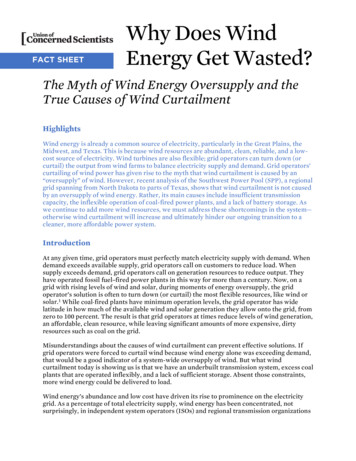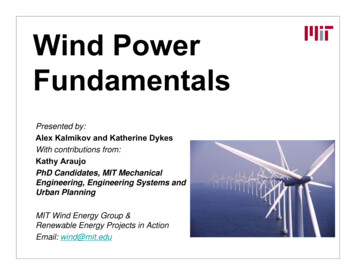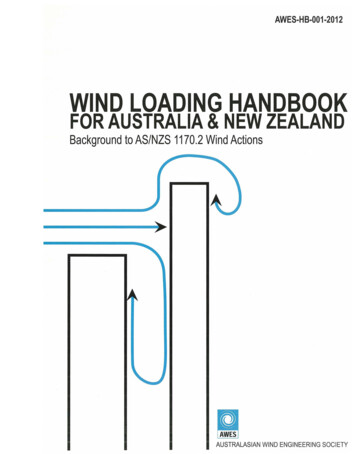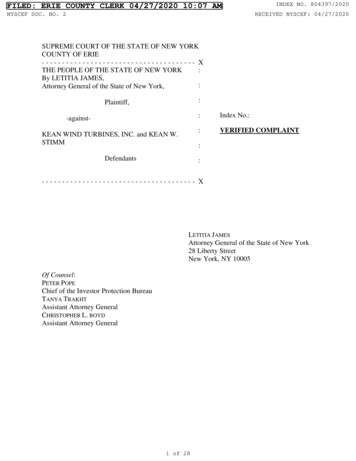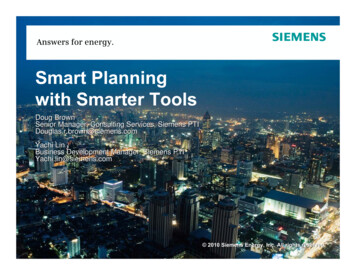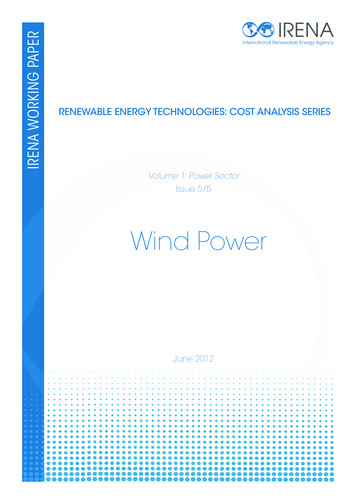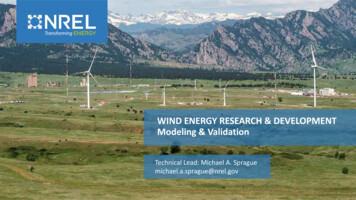
Transcription
WIND ENERGY RESEARCH & DEVELOPMENTModeling & ValidationTechnical Lead: Michael A. Spraguemichael.a.sprague@nrel.gov
Modeling & ValidationAdvancing wind plant technology development by creatingopen-source modeling tools and high-performance computingcodes that simulate the behavior of wind power technologiesin complex environments and create a deeper understandingof complex flow physics and turbine dynamics.High-Fidelity Modelingand ValidationEngineering Modelingand ValidationSystems Engineering Designand OptimizationCreating a new suite of models andhigh-performance computing codes topredict and understand complex flowand turbine dynamicsImproving, validating, and applyingphysics-based engineering models anddesign tools to advance wind planttechnologyDeveloping an analysis platform toleverage NREL’s research capabilitiestoward integrating wind energyengineering and cost models acrosswind plantsNREL 2
High-Fidelity Modeling & ValidationNalu-Wind simulation of the NREL Phase VI turbine under yawedconditions. Simulation performed on NREL’s Eagle supercomputer. NREL develops open-source, high- and mid-fidelity predictivemodeling and simulation capabilities for wind turbines.Areas of Expertise Using our high-performance-computing capabilities, NREL’ssimulations are designed to create a deeper understanding ofcomplex flow physics and turbine dynamics. High-performance computing Validation, predictive modeling, and simulation Software engineering for open-sourcecommunity codes. High- and mid-fidelity modeling of fluids and structuresNREL 3
CurrentProjectsHigh-Fidelity ModelingCHALLENGEExisting models cannot predict the complex fluid and turbine dynamics inmodern wind power plants, which include floating platforms for offshore wind,complex terrain for land-based wind, and large flexible rotors.APPROACHIn collaboration with the ExaWind project, NREL and its partners are creatinga new suite of open-source, high-fidelity models that predict wind powerplant dynamics and are backed by rigorous verification and validation.IMPACTHIGH-FIDELITY MODELINGAND VALIDATIONPredictive high-fidelity simulation enables the United States to make radicalleaps in its ability to: Understand and resolve wind plant dynamics in atmospheric flow Explore disruptive technology innovations Perform final-design checks Calibrate, validate, and improve lower-fidelity models.NREL 4
CurrentProjectsExascale Computing Project:ExaWindCHALLENGEHigh-performance computing (HPC) is changing rapidly, with newsupercomputers being centered on graphical processing units (GPUs) forspeed. However, codes that run well on traditional CPU-based HPC needmajor overhauls in algorithms and software to utilize GPUs.APPROACHIn collaboration with the High-Fidelity Modeling project, NREL and itspartners are creating open-source codes with excellent computationperformance portability, with an emphasis on next-generationsupercomputers accelerated by GPUs.HIGH-FIDELITY MODELINGAND VALIDATIONIMPACTExaWind ensures that needed wind simulations will be eligible to leveragemodern supercomputers, especially DOE leadership-class supercomputersand the first exascale-class supercomputers.NREL 5
010100101110001001110000011Engineering Modeling and Validation NREL enables the development of advanced wind planttechnologies by leveraging knowledge and data to improvephysics-based engineering design competence and tools. NREL works collaboratively with the wind energy communityto develop, validate, and apply engineering tools at the windturbine, offshore support structure, and full wind plant levels.Areas of Expertise Develop, verify, and validate physics-basedengineering tools Loads analyses Identify design-driving conditions.NREL 6
WavemakerBeachZCurrentProjectsOffshore Code ComparisonCollaboration, Continuation,with Correlation, andunCertainty (OC6) ProjectStructuraldynamicsXHydrodynamicsoptical targetCHALLENGETo ensure the reliability and cost-effectiveness of offshore wind systems, offshoredesign codes that consider the coupling between aerodynamic and hydrodynamicloading need to be validated for a variety of designs and conditions.APPROACH010100101110001001110000011NREL is leading an international collaborative effort to validate the most criticalphenomena in predicting offshore wind system loads. A three-way validationand verification process compares solutions from the new coupled engineeringlevel models to high-fidelity models and experimental data.IMPACTENGINEERING MODELINGAND VALIDATIONValidation will increase the level of trust and acceptance in offshore wind designtools, which directly affects the perceived risk in a project, impacting designmethodology and bankability. Validated modeling tools can then be used todesign next-generation offshore wind systems that will have lower costs.NREL 7
CurrentProjectsModeling To EnableNext-Generation of FloatingOffshore Wind Turbines010100101110001001110000011ENGINEERING MODELINGAND AeroDynWind-InflowAerodynamicsWind TurbineControl System & ationNacelle DynamicsServoDynTower DynamicsElastoDyn------- -------HydroDynCHALLENGEHistorically, the substructure of floating offshore wind turbines has been modeledO rigidly, which is an impediment to their design—especially newer designs that are( streamlined, flexible, and cost effective.bDynorDynAPPROACHNREL is upgrading OpenFAST to compute substructure flexibility and member-levelloads. In collaboration with Stiesdal, we are validating the new capabilities throughmodel-to-model comparisons and comparisons with experimental data generated inwave-tank testing using the TetraSpar design.IMPACTThe upgraded OpenFAST tool will enable the design and optimization of the nextgeneration floating wind systems that show promise for making floating offshorewind cost competitive with other energy technologies.NREL 8
AEPSocialOpExGridMetoceanTurbineCapExWildlifeBOS CapExSystems Engineering and Optimization Integrate wind plant engineering performance and cost softwaremodeling to enable full system analysis. Apply a variety of advanced analysis methods in multidisciplinarydesign analysis and optimization, and related fields, to the study ofwind plant system performance and cost. Develop a common platform and toolset to promote collaborativeresearch and analysis among national laboratories, industry, andacademia.Areas of Expertise Modeling wind turbines and plants together,multidisciplinary analyses, and overall cost ofenergy Assessing system engineering and costimpacts of technology or logistic innovations.NREL 9
CurrentProjectsWind Energy with IntegratedServo-Control (WEIS)CHALLENGETo reliably produce power and reduce motion and loads, floating offshore platforms tend to beextremely large and stiff, which also means they are quite expensive. System-level complexityhas hindered next-generation designs.APPROACHBuild on existing design optimization and cost estimation capabilities in NREL’s WISDEM tool,the floating offshore wind analysis capability in OpenFAST, and advanced control theory tocreate a multifidelity tool capable of controls codesign for floating offshore wind turbines.SYSTEMS ENGINEERINGAND OPTIMIZATIONIMPACTCost-competitive floating offshore platforms and turbines designed a priori with customizedcontrol actuators to achieve the lowest capital cost while maximizing power output andoperational lifetimes.NRELLNRE 10
or bock Iron and rlCurrentProjectsInternational Energy Agency(IEA) Wind 15-MW ReferenceWind TurbineMain sho/t/:Nose tL-----1150mTransition PieceMean Sea Level15m30mMonopile and Semisubmersible Support StructuresDetailed Blade DesignPMDD Generator DesignCHALLENGEWind energy researchers and engineers need openly defined reference windturbines (RWTs) as the platforms on which to publicly demonstrate and shareadvances in modeling and design. The existing slate of RWTs has not kept pacewith the power-rating growth of commercial wind turbines.APPROACHUnder coordination of IEA Wind Task 37, NREL led the design effort of a new,modern, 15-MW RWT featuring both fixed-bottom and floating-supportstructures; the RWT is completely open and documented.IMPACTSYSTEMS ENGINEERINGAND OPTIMIZATIONEnables collaboration with industry without sharing intellectual property,provides a common baseline model for which research teams around the worldcan demonstrate research advances, and establishes an education resource forunderstanding the fundamentals of wind turbine design.NRELL 11NRE
CurrentProjectsWind-Plant Integrated SystemDesign & Engineering Model(WISDEM)CHALLENGENew technologies or component innovations often come with a price premiumand system impacts, but it can be difficult to do levelized cost of energy roll-up.APPROACHNREL researchers integrated cost and engineering models into a single,multidisciplinary framework, WISDEM.IMPACTSYSTEMS ENGINEERINGAND OPTIMIZATIONRapid design optimization, sensitivity and trade-off studies, and system impactassessment.NREL 12
Accomplishments & ImpactsNREL researchers have unique simulationcapabilities that include high-fidelity andengineering modeling and validation—as well assystems engineering design and optimization.These capabilities are supported by the lab’s highperformance supercomputers and areexemplified by: The DOE Exascale Computing Project, which establishedthe open-source ExaWind modeling and simulationenvironment: https://github.com/exawind/ NREL researchers who will lead in expanding the ExaWindcode for floating offshore wind turbines. By collaboratingwith the DOE Exascale Computing Project, the team willrun some of the highest-fidelity wind power plantsimulations on the first exascale-class supercomputersthat are scheduled to go online in 2022.The github animation shows the velocity isosurface at 5.5 m/s from 2.7 s to 8.6 s of ageometry-resolved large-eddy simulation of the NREL 5-MW wind turbine. The simulation wasperformed on the NERSC Cori system with Nalu-Wind, which is an unstructured-grid, lowMach-Number computational fluid dynamics code. The code development and simulationsare being performed as part of the U.S. Department of Energy ExaWind Exascale ComputingProject and the DOE EERE Wind Energy Technologies Office High-Fidelity Modeling project.
Modeling & Validation. Advancing wind plant technology development by creating open-source modeling tools and high-performance computing codes that simulate the behavior of wind power technologies in complex environments and create a deeper understanding of complex flow physics and turbine dynamics. High-Fidelity Modeling and Validation

